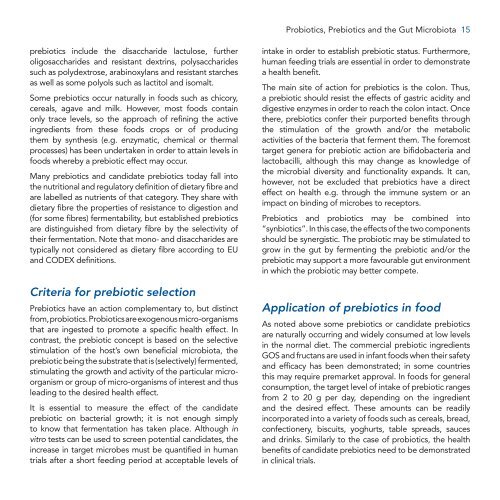probiotics, prebiotics and the gut microbiota - International Life ...
probiotics, prebiotics and the gut microbiota - International Life ...
probiotics, prebiotics and the gut microbiota - International Life ...
You also want an ePaper? Increase the reach of your titles
YUMPU automatically turns print PDFs into web optimized ePapers that Google loves.
Probiotics, Prebiotics <strong>and</strong> <strong>the</strong> Gut Microbiota 15<strong>prebiotics</strong> include <strong>the</strong> disaccharide lactulose, fur<strong>the</strong>roligosaccharides <strong>and</strong> resistant dextrins, polysaccharidessuch as polydextrose, arabinoxylans <strong>and</strong> resistant starchesas well as some polyols such as lactitol <strong>and</strong> isomalt.Some <strong>prebiotics</strong> occur naturally in foods such as chicory,cereals, agave <strong>and</strong> milk. However, most foods containonly trace levels, so <strong>the</strong> approach of refining <strong>the</strong> activeingredients from <strong>the</strong>se foods crops or of producing<strong>the</strong>m by syn<strong>the</strong>sis (e.g. enzymatic, chemical or <strong>the</strong>rmalprocesses) has been undertaken in order to attain levels infoods whereby a prebiotic effect may occur.Many <strong>prebiotics</strong> <strong>and</strong> c<strong>and</strong>idate <strong>prebiotics</strong> today fall into<strong>the</strong> nutritional <strong>and</strong> regulatory definition of dietary fibre <strong>and</strong>are labelled as nutrients of that category. They share withdietary fibre <strong>the</strong> properties of resistance to digestion <strong>and</strong>(for some fibres) fermentability, but established <strong>prebiotics</strong>are distinguished from dietary fibre by <strong>the</strong> selectivity of<strong>the</strong>ir fermentation. Note that mono- <strong>and</strong> disaccharides aretypically not considered as dietary fibre according to EU<strong>and</strong> CODEX definitions.Criteria for prebiotic selectionPrebiotics have an action complementary to, but distinctfrom, <strong>probiotics</strong>. Probiotics are exogenous micro-organismsthat are ingested to promote a specific health effect. Incontrast, <strong>the</strong> prebiotic concept is based on <strong>the</strong> selectivestimulation of <strong>the</strong> host’s own beneficial <strong>microbiota</strong>, <strong>the</strong>prebiotic being <strong>the</strong> substrate that is (selectively) fermented,stimulating <strong>the</strong> growth <strong>and</strong> activity of <strong>the</strong> particular microorganismor group of micro-organisms of interest <strong>and</strong> thusleading to <strong>the</strong> desired health effect.It is essential to measure <strong>the</strong> effect of <strong>the</strong> c<strong>and</strong>idateprebiotic on bacterial growth; it is not enough simplyto know that fermentation has taken place. Although invitro tests can be used to screen potential c<strong>and</strong>idates, <strong>the</strong>increase in target microbes must be quantified in humantrials after a short feeding period at acceptable levels ofintake in order to establish prebiotic status. Fur<strong>the</strong>rmore,human feeding trials are essential in order to demonstratea health benefit.The main site of action for <strong>prebiotics</strong> is <strong>the</strong> colon. Thus,a prebiotic should resist <strong>the</strong> effects of gastric acidity <strong>and</strong>digestive enzymes in order to reach <strong>the</strong> colon intact. Once<strong>the</strong>re, <strong>prebiotics</strong> confer <strong>the</strong>ir purported benefits through<strong>the</strong> stimulation of <strong>the</strong> growth <strong>and</strong>/or <strong>the</strong> metabolicactivities of <strong>the</strong> bacteria that ferment <strong>the</strong>m. The foremosttarget genera for prebiotic action are bifidobacteria <strong>and</strong>lactobacilli, although this may change as knowledge of<strong>the</strong> microbial diversity <strong>and</strong> functionality exp<strong>and</strong>s. It can,however, not be excluded that <strong>prebiotics</strong> have a directeffect on health e.g. through <strong>the</strong> immune system or animpact on binding of microbes to receptors.Prebiotics <strong>and</strong> <strong>probiotics</strong> may be combined into“synbiotics”. In this case, <strong>the</strong> effects of <strong>the</strong> two componentsshould be synergistic. The probiotic may be stimulated togrow in <strong>the</strong> <strong>gut</strong> by fermenting <strong>the</strong> prebiotic <strong>and</strong>/or <strong>the</strong>prebiotic may support a more favourable <strong>gut</strong> environmentin which <strong>the</strong> probiotic may better compete.Application of <strong>prebiotics</strong> in foodAs noted above some <strong>prebiotics</strong> or c<strong>and</strong>idate <strong>prebiotics</strong>are naturally occurring <strong>and</strong> widely consumed at low levelsin <strong>the</strong> normal diet. The commercial prebiotic ingredientsGOS <strong>and</strong> fructans are used in infant foods when <strong>the</strong>ir safety<strong>and</strong> efficacy has been demonstrated; in some countriesthis may require premarket approval. In foods for generalconsumption, <strong>the</strong> target level of intake of prebiotic rangesfrom 2 to 20 g per day, depending on <strong>the</strong> ingredient<strong>and</strong> <strong>the</strong> desired effect. These amounts can be readilyincorporated into a variety of foods such as cereals, bread,confectionery, biscuits, yoghurts, table spreads, sauces<strong>and</strong> drinks. Similarly to <strong>the</strong> case of <strong>probiotics</strong>, <strong>the</strong> healthbenefits of c<strong>and</strong>idate <strong>prebiotics</strong> need to be demonstratedin clinical trials.
















